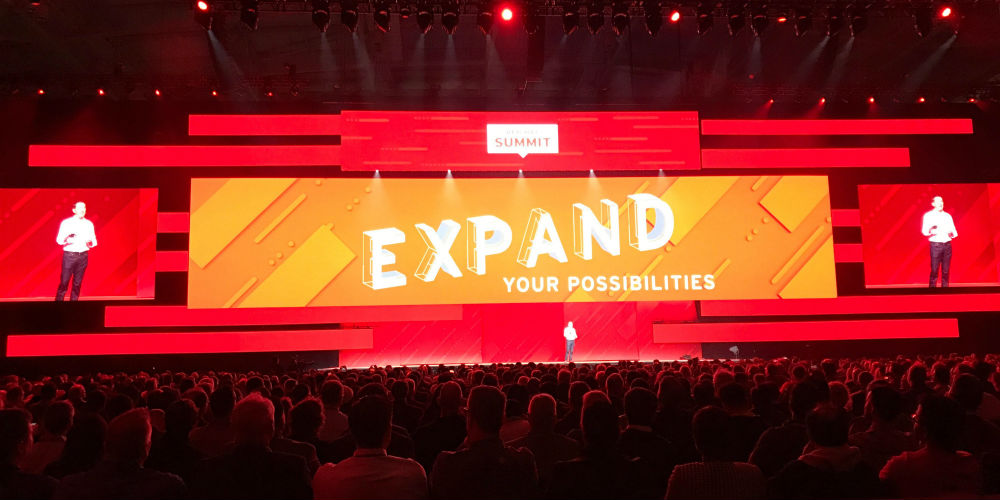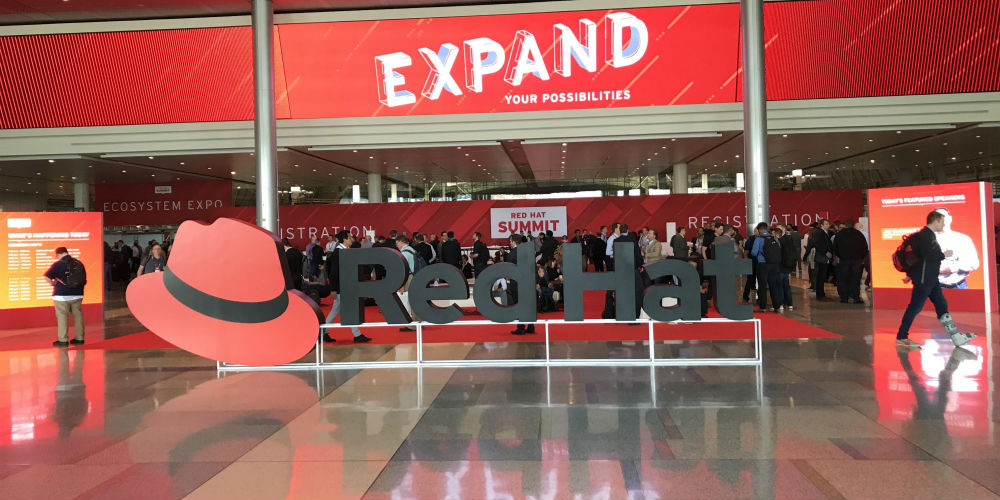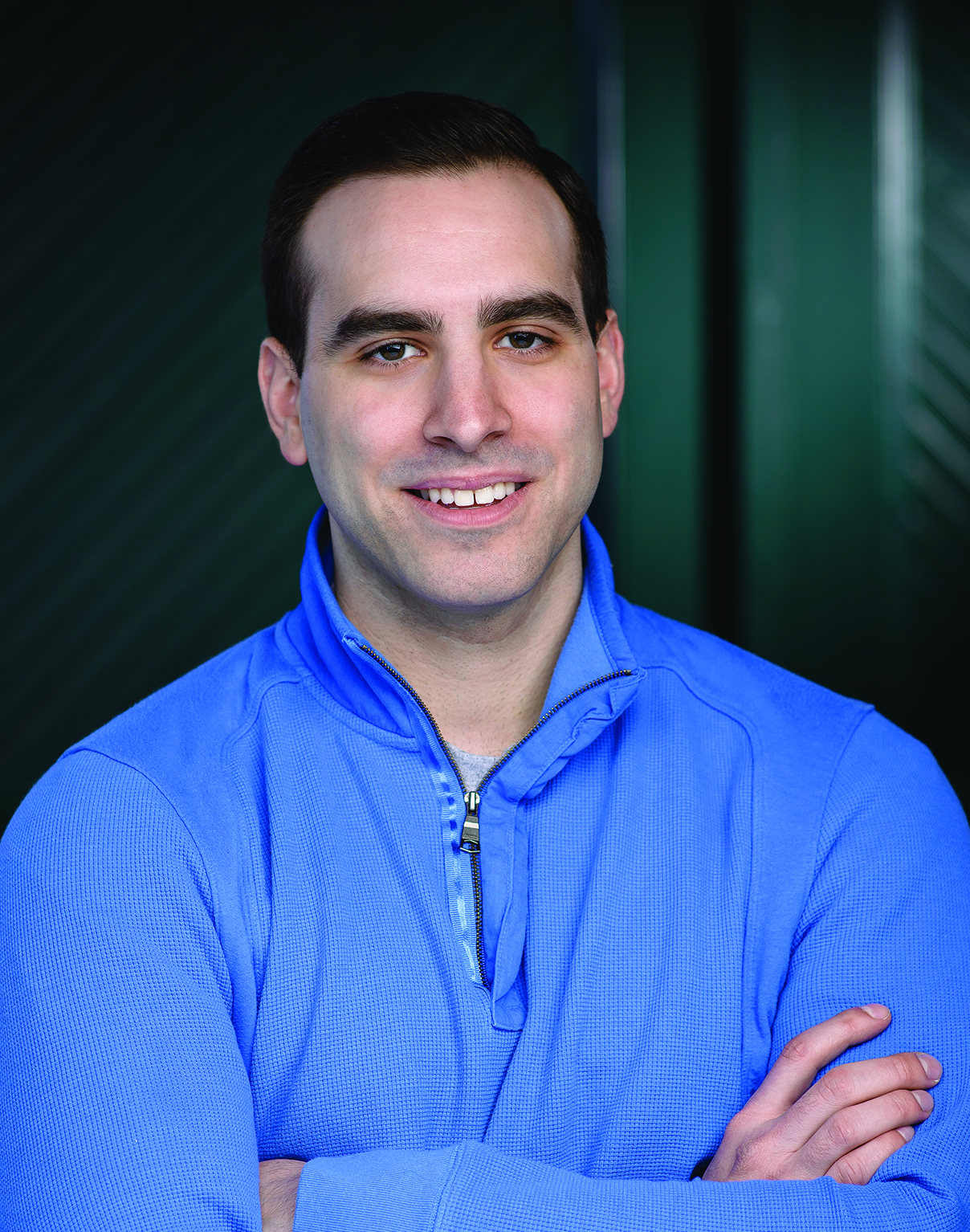Perhaps I’m showing my ignorance of the industry here, but when I decided to attend Red Hat Summit 2019 in Boston, MA this week I wasn’t ready for the experience I was walking into. I expected a typical trade show – booths, sessions, a keynote at the end of the first day in a modest ballroom. I attended the show because it was local – and I’m glad I did. It turns out that our audience is crazy about open source.
I arrived for the keynotes on the first day, waited for the doors to open, and followed the crowd. We skipped through the tradeshow floor, now dark and roped off, and suddenly I was in a long, dark hallway, crossing beam-lights making “X” shapes for the crowd to walk beneath. The sides lined with tables full of wine and beers for the crowd to enjoy. At the other end the keynote stage – seventy feet across at least, with the largest video wall perhaps forty feet long by ten feet high, flanked by two ten by ten video walls. A lone DJ on stage playing everything from Cardi B to Stevie Wonder.
Thousands were in the crowd, and each seat held a dedicated bracelet that would eventually light up along with the show. Was I at a technology show? A rave? A rock concert? I wasn’t sure until Red Hat CEO Jim Whitehurst stepped on stage to discuss the theme of this year’s show – Expand Your Possibilities.
Clearly Red Hat Summit was much more than I expected, and that was proven further as the keynote sessions continued. Read on to learn more about the insights and understanding coming out of the keynotes from Red Hat Summit 2019, company by company – specifically how these companies used open source to improve their organizations:
Ginni Rometty, President and CEO, IBM*
*IBM is currently in the process of purchasing Red Hat
- IBM has been working with open source for twenty years. In 1999, IBM invested $1 Billion into open source and Red Hat. It plans on purchasing Red Hat for $38 Billion
- The roots between the two companies are deep, and the beliefs in how important an ecosystem is to drive innovation are as well
- The importance of open governance is vital to open source, and if you want to take then you have to give. You can use it, but you have to contribute
- Both companies saw that they had joint clients, and many non-joint clients as well. There is plenty of mission critical work that has yet to move to the cloud, public or private. You need to have a way to connect all of those pieces.
- The timing is right between IBM and Red Hat because there is a fabric for a standard to do this across the globe. The opportunity is right in front of so many clients – they want to address this. Moving data to the cloud, where date needs to be, and hybrid environments. It’s time for chapter two for many clients, and the demand for Open source is stronger than ever.
- IBM and Red Hat will work together, but perhaps not come together in the traditional sense. To preserve the value of Open source – all welcome – is part of the mission as well. The mission is to scale Open source.
- Red Hat will stay an independent unit. The idea of having a platform that invites innovation for everyone means open source, open standards, friends and competitors alike. IBM can help power it to make it go further and wider. A broad horizontal scale. The work that Red Hat has done to create its culture is important, and so the companies will work together.
- IBM will change, building on top of what Red Hat has done. Offering clients a secure mission critical, hybrid stack. A bigger and broader plate for innovation everywhere.
- All companies are on a journey. There’s been plenty of experimentation, which is great. Now, however, we’re at the stage of scaling. We aren’t sprinkling in technology, we’re at the stage of true transformation. Exciting possibilities include cloud, all of the forms of artificial intelligence augmenting human work, blockchain fundamentally changing supply chains, and quantum computing.
- This acquisition is a win for clients.
Rahul Samant, EVP and CIO, Delta Airlines
- Delta has transformed IT in order to transform the customer experience. It is working to be one of the world’s most trusted brand. That means people first, but technology next.
- Two years ago Delta had data all across the company. The first goal was to gather that data into repositories. The company is building APIs and hosting them in Red Hat Data Shift, so all employees can gain insights on customers to increase service and personalize customer experience.
- Before flying, you get emailed a menu of what you will be able to select on your flight. From there, they have automated, single-click check-in. Delta is the pioneers in using RFID technology to track bags from gate to gate. Those experiences are being built off of a digital foundation.
- On the operation side, they are doing machine learning oriented decision support. When they suffer irregular operation, such as bad weather, they make sure the decision support tools are in the hands of front-line people. That way the decisions on delays and cancels can be augmented, technology helping human decisions.
- All of this technology is sitting on the scalable, reliable platform of Red Hat. Red Hat is below the hood, and the customers experience the outcome.
- The technology vision is easy. It needs to be contextualized. In 2016, when this transformation started, the timing was off. They needed to focus on the basics of the platform. Fast forward a year and a half and they were ready for the transformation – hiring 600 new people with contemporary skills and abilities, and making sure they blend in with legacy employees. Delta focused on the human factors to make sure there wasn’t friction between the two groups.
- There is a war for talent. Working with partners not only brings great products, but help to bring great talent to the digital transformation.
Austen Smack, Container Platforms Product Owner, ExxonMobil
- ExxonMobil embraces technology to solve energy challenges. Geoscientists are using Open Shift to change the way they work through disruptive innovation.
- Disruptive innovation is the idea of introducing new technology that might not have short-term effects, but will pay off in the long-term. ExxonMobil watched customers as they did their work to learn what needed to change. Specifically with container platforms.
- They started with a small sandbox cluster, and continued to deploy more non-production clusters. As of today, there are over 130 development teams consuming resources on ExxonMobil’s platform.
- They keep up with these developer teams by surrounding themselves with people that are willing to disrupt, and bringing vendors with them throughout the process. Red Hat and other vendors have been on the team since day one.
- Everything they are doing is automated. Everything is infrastructure as code. Investing in extra time for automation will reduce technical debt.
- Containerization allows ExxonMobil to expand delivery options and enable quicker code iterations, then deliver those solutions quickly to customers. Customers might not know that at this point, however. Customers don’t want to put in the work unless it makes sense to them. Containerization expanded delivery options, allowed customers to better collaborate, and allowed for the deployment of solutions. ExxonMobile deployed a data science image, and customers only had to click on a URL to access the application. They could instantly visualize code, and because of that the customers could work with ExxonMobil to make better business decision, faster. It took hours instead of weeks. The only limitation is how quickly the data scientists can code.
Michael Cawood, VP of Product Development, F-16/F-22 Integrated Fighter Group, Lockheed Martin
- Lockheed Martin is under two threats – nation-states creating technology to render planes useless, and competitors fighting to take business away from Lockheed Martin.
- Traditionally the development of F-22 were a long process. Two to three years to develop a plan, and five to seven years to develop new capabilities. They utilized a Waterfall method of development, creating hardware and software independently. Flight tests took over a year before certification. Supply chain processes and hardware development cycles sometimes took years. The organization was siloed, and timelines were longer due to working with secure government systems.
- Six years ago, Lockheed implemented Agile methods, but didn’t achieve any improvement.
- In 2017 the company partnered with Red Hat. They changed tools, facilities, process, and culture utilizing Red Hat Open Innovation Labs.
- The approval of software tools has been sped up from months or years to a few days. They are using companies to build and deliver hardware in five to ten days instead of years. Forecasting improved 40%. They are now on track to deliver communications capability to the F-22 three years earlier than the original plan.

Michael Denecke, Head of Test Technology, Volkswagen
- Michael’s job is to make sure all control units work properly together. The new challenge of autonomous driving falls under his scope. The normal way to do tests were not enough.
- Volkswagen got the idea to do all of the tests on virtual test requirements. They used Red Hat to put these tests in virtual containers. They chose Red Hat because, after speaking to a number of IT vendors, Red Hat was the only one to say it could be done.
- Volkswagen had a short timeframe to prove the viability of the idea. The Red Hat Open Innovation Labs allowed them to reach the goal in this short timeframe. The Open Innovation Labs showed Volkswagen to not worry about top-down innovation, but to put the onus on the team.
- First they proved they could have virtual test environments. Then they proved they could mix virtual and physical testing environments. Finally, they showed that quality and success was dependent on changing the culture and collaborating.
- No matter how crazy an idea seems, if you believe in it and it gives a business advantage then look into it. Trust your teams, and give them the responsibility to decide on their own.
David Gledhill, CIO and Head of Group Technology & Operations, DBS Bank Unlimited
- Ten years ago they started their digital transformation. Five years ago, they saw what was going on in China with banking disruption. The traditional physical branching wasn’t going to work. They decided to drive a digital bank.
- They were used to a traditional stack, and needed to change that as well. They needed to become a technology company, and looked at some of the biggest players to find out how to be like them.
- They weren’t building technology like a bank. They moved to open stack and used Red Hat to help with that. They built out the cloud environment, and continued to scale.
- The goal was to make banking invisible, which needed a lot of engineering. The customer toil needed to be taken out of it. They also needed to think about the ecosystems – how to create them and how to be part of others. They needed to be able to scale without concern, and build APIs (DBS has 350 and counting).
- As they transformed, they wanted to take the whole bank along with it. Learning how to fail fast was difficult, but also become a culture of continuous learning and development. The cultural shift has been the biggest part of setting the company apart.
Tom Gilbert, Global Head of Cloud, Deutsche Bank
- Deutsche Bank has created an Everything-as-a-Service platform, aimed at opening up new ways of working and allowing developers to get new ideas into production. They also wanted to use their own infrastructure more productively.
- Fabric, Deutsche Bank’s EaaS platform, is built on Red Hat OpenShift. 25,000 production containers are held on the platform to date. They are being brought to market in just three weeks.
- The technical capabilities have helped to foster communities in the bank so anyone can contribute to the platform. New iterations are introduced every few weeks. Rapid prototyping is available on demand. External developers and third parties can supply software, and test applications in the environment.
- As of today they are running over 25,000 container in production.
- They are running Fabric in multiple premises through multiple suppliers. On-premise IT has multiple suppliers providing data center services, and off-premises in the cloud they are using Microsoft Azure. They can write once and run everywhere. If they need massive scale at short notice for a short period, for example deploying new products into new regions quickly, it’s now possible thanks to the combination of OpenShift and Azure.
- This hybrid cloud platform on OpenShift let them build all of the controls and automation into the platform, enabling applications in the highly-regulated bank to consume the public cloud while reducing risk.t has also reduced cost and increased agility.
Satya Nadella, CEO, Microsoft
- Microsoft and Red Hat have made much progress together, and announced at they keynote the general availability of the Azure OpenShift service, a collaboration between Microsoft and Red Hat.
- Believers in distributed computing, hybrid computing, and edge computing will appreciate the flexibility and agility provided from this partnership.
- One thing Microsoft is focusing on is getting data centers to meet the real needs of customers. Ensuring certifications needed don’t create friction for customers. Also the number of regions available – Microsoft has just launched its first data center region in Africa.
- Nadella is most excited about the number of software engineers being hired outside of the tech industry. It means that software is becoming a new factor of production in every industry. That means computing and architecture is going to change – everything from storage, to cloud, artificial intelligence, quantum, and all the stops between.
- The thing that truly needs to happen is to ensure the cost structure of raw infrastructure and the innovation platform is something that makes every business competitive. Support of open source and support for standards will reduce the friction of development. The second area is democratizing technology. Machine learning, DevOps, data science – those technologies need to be available to anywhere out there so any company can take them and build on them. It’s up to platform vendors to reduce the barriers.
- Five years ago Microsoft and Red Hat had an adversarial relationship. Moving forward, Microsoft is committed to the partnership because it’s driven by what customers expect of them – interoperability and commitment and contribution to open source.
If you enjoyed this article and want to receive more valuable industry content like this, click here to sign up for our digital newsletters!











[…] 8 Open Source Digital Transformation Journeys from Red Hat Summit 2019 Keynote […]